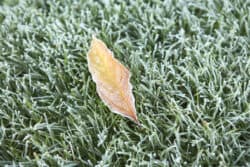How to Take Care of Your Lawn During Winter
Many of us already perform some sort of winter-proofing to protect our lawns and gardens during the colder months. Bringing potted plants indoors when the temperature drops, storing lawn furniture in a shed or garage, and raking leaves during the fall are all common chores in nearly every state. You might be tempted to sit back and enjoy the fruits of your labor now, but, depending on where you live, there’s probably some more lawn maintenance in the forecast.
Dealing with Snow and Ice
Some of us love it and others despise it. Either way, it’s easy to see how snow and ice can become a real nuisance. Before you reach for your snow shovel, however, there are some tips to consider before beginning snow and ice removal.
Avoid Piling Snow on Your Lawn
Shoveling snow is a big enough hassle as it is, but you should avoid dumping large piles of snow into small, concentrated areas on your lawn. The added weight of the snow can compact the soil beneath your lawn, ultimately leading to dry spots or drainage problems.
If you must dump shoveled snow onto your lawn, try to spread it around instead of making large piles. Not only does this help the snow melt evenly when the temperature starts to warm up, but it helps you avoid brown patches of grass in the springtime.
Never Use Salt on Your Grass
Salt is often used on icy surfaces to help breakup the ice and create traction for pedestrian or vehicle traffic. As such, it’s often used in and around your lawn. But salt and other de-icing products can actually damage your lawn and prevent the proper uptake of nutrients. Come spring, this results in bare spots and patchy lawns.
If you do have to treat the icy surfaces around your home, find products that don’t contain sodium chloride. Calcium chloride is a great alternative that won’t kill your grass. When shoveling snow, avoid putting salted snow on your lawn. The residue will seep through the snow and make its way into your grass.
Minimize Foot Traffic
You might be tempted to build a snowman or snow angel in your backyard, but you should really try to minimize foot traffic in snowy areas of your lawn in order to avoid compaction. Likewise, avoid parking vehicles on your grass whenever possible – especially for extended periods of time.
Taking Advantage of Warm Weather
Different regions experience winter in varied ways. While some areas might only see a few days below freezing, others spend several months dealing with snow and ice. Regardless of your situation, you should always take advantage of snow melts, sunny days, and warm spells.
Spread Seed and Fertilizer
Breaks in the snow present great opportunities to spread grass seed, fertilize your lawn, and lay sod. Grass seed meant for cool weather is ideal in areas with little to no snowfall, as it will help you maintain a green, lush lawn throughout the winter months.
Likewise, applying winter fertilizers, which usually contain large amounts of nitrogen, will give your lawn a deep reserve of energy during colder temperatures.
Eliminate Weeds
While weeding is often performed in the spring, it can be done on the warmer days of the wintertime, too. Removing them now will give you a headstart once the weather warms up, and pre-emergent weed killer can also be used as long as the ground isn’t frozen.
Rake and Water Your Lawn
Depending on where you live, it might seem strange to rake leaves or water your lawn during the winter months. However, staying on top of these chores will benefit your lawn in numerous ways. Raking in the early winter ensures that you’ve picked up any leaves you might have missed in the fall, and watering during a midwinter drought provides your lawn with much-needed hydration. It also helps avoid clover mites that tend to seek out dry lawns and soil.
Performing Lawn Care and Maintenance in the Winter
Although the winter months are a great opportunity for family gatherings, rest, and relaxation, it’s not the time to ignore your lawn. Putting in a little bit of time and effort now will help prepare your lawn for springtime and ensure it remains healthy all year round.

